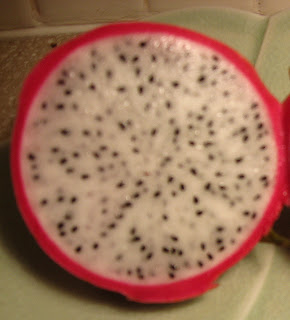Radishes evoke childhood memories of gardening for me. They sprout so easily and within a few weeks you have some food!
Radishes,
Raphanus sativa, belong to the cabbage family. Some resources indicate that the origin of radishes was China, but others mention a western Asian origin.The part we eat is the swollen lower stem.
They were known to the Ancient Egyptians, and black radishes appeared on the walls of tombs. The Ancient Greeks and Romans also ate radishes.
A black radish is shown on the right. This evening I compared the taste of a black radish, a daikon, and a watermelon radish. The black radish at first tasted pretty mild, but as I chewed the flesh of the radish it became quite pungent.
An enzyme in the radish and a precursor compound are separated until chewing damages the radish cells and when the enzyme mixes with the precursor compound, and forms a volatile mustard oil. Most of the enzyme is found in the skin, so if you peel the radish, much of the pungency will be gone.
The picture on the left shows the black radish next to the daikon and the watermelon radish. The black radish was the most pungent and was a bit tough when eaten raw. This type of radish is often cooked.
The daikon, the long, white radish seemed fairly mild. It was not as tough as the other two radishes. Daikons are pickled in Korea, to preserve them for the cold winter months. Along with cabbage, daikons are important ingredients of Kimchi, the Korean National Dish.
The green radish is the watermelon radish. It has red flesh inside. The slices on the right show the watermelon radish in the middle, black radish on the right, and daikon on the left.
Radishes have some great nutritional benefits! One cup provides 1/3 of the recommended daily allowance of vitamin C. It contains compounds that help protect against some cancer, protect the liver, and helps detoxify the body.
Radishes are low in calories and high in fiber, therefore they can be helpful when trying to lose weight.
More information can be found at
http://www.livestrong.com/article/17858-nutritional-value-radishes/.












































